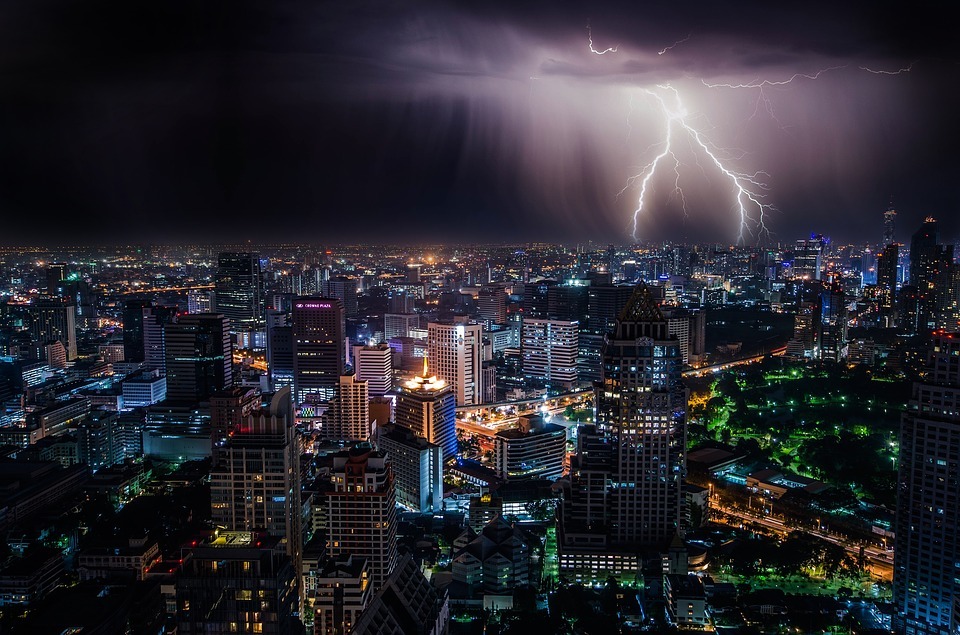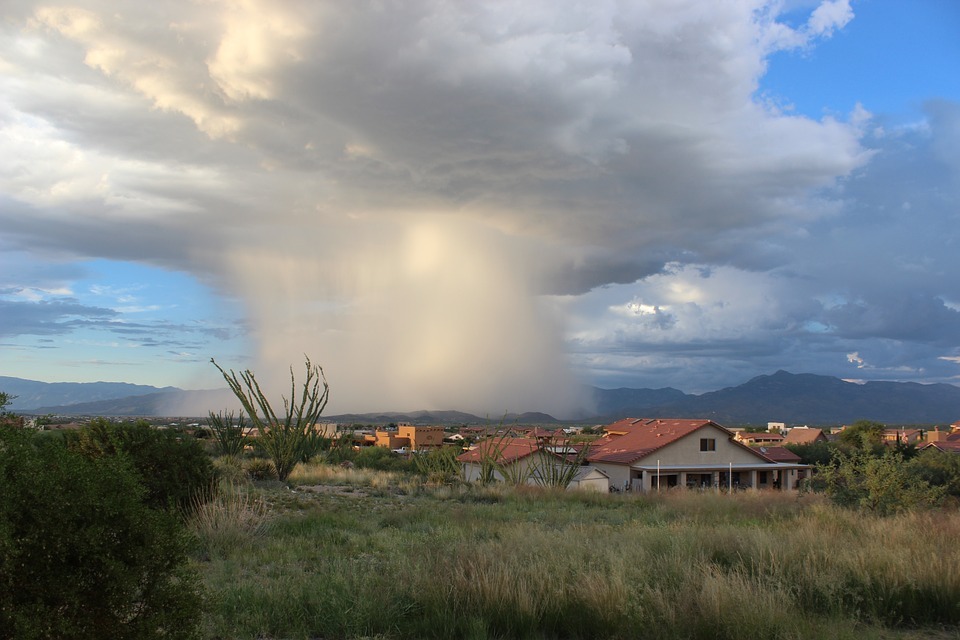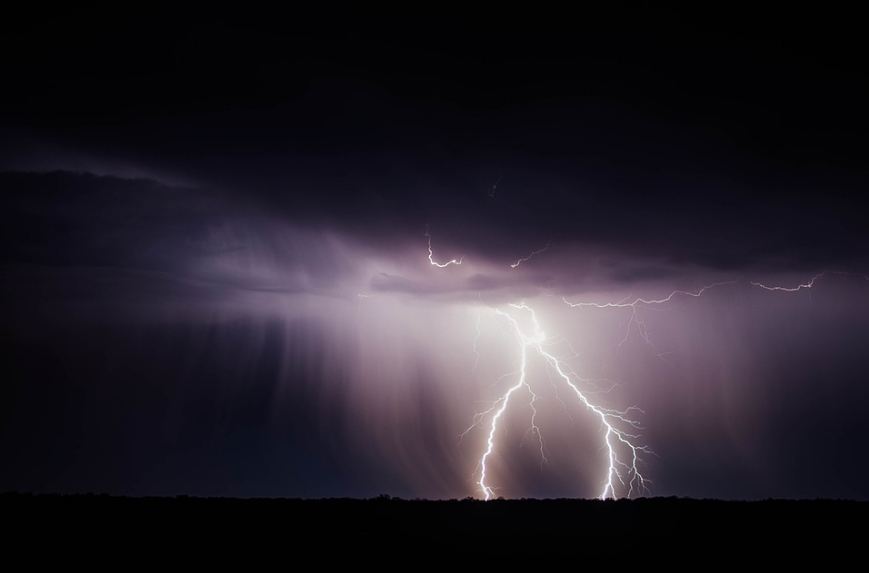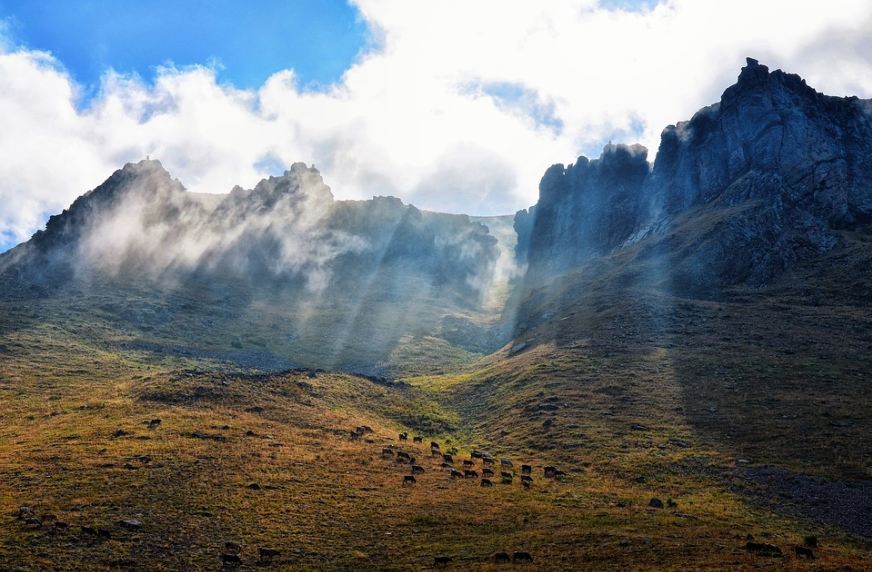What Are the Different Colors of Lightning?
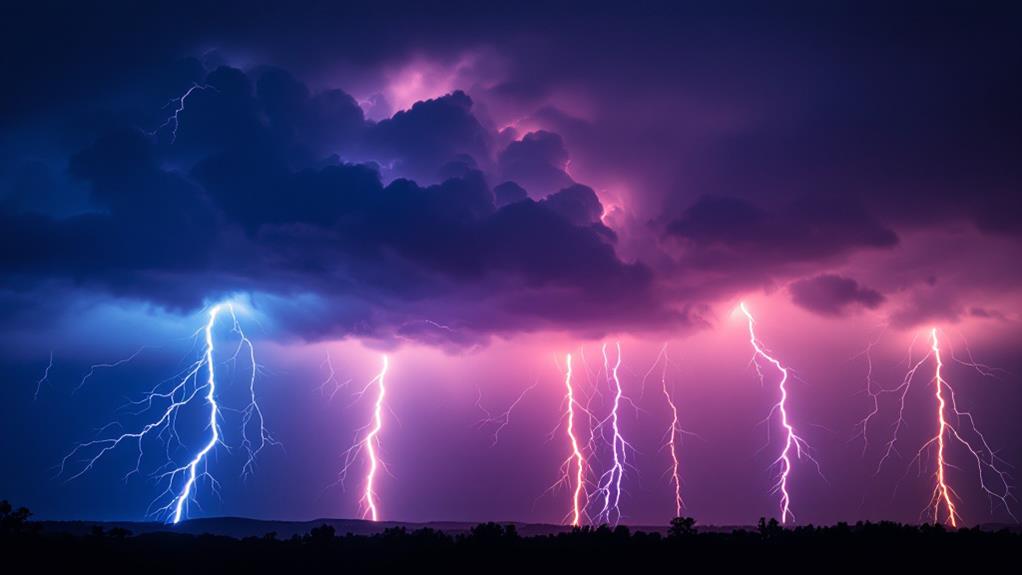
Lightning isn't just white; it can captivate you with a range of colors. You might see brilliant blue bolts in winter storms or high-altitude flashes. Purple lightning often appears during powerful storms at twilight. Red sprites and ELVES create fiery displays, while orange bolts cast an eerie glow over dusty landscapes. Yellow strikes are common in dry, polluted air, and green flashes signal severe storms. Pink lightning can warn of hazardous weather. The color you see depends on factors like humidity, dust, distance, and temperature. Revealing the mysteries of these colorful bolts unveils fascinating insights into our atmosphere.
White Lightning
In spite of its name, white lightning isn't actually white. What you're seeing is a combination of all the colors in the visible spectrum blending together, creating the illusion of white. This type of lightning is the most common and what you'll typically observe during a thunderstorm.
White lightning occurs when electrical discharges travel through clear air with minimal obstructions. The bright flashes you witness are the result of superheated air molecules that rapidly expand and contract. This process creates a luminous plasma channel, which appears white to your eyes.
You'll often see white lightning as jagged bolts stretching across the sky or between clouds and the ground. It's incredibly intense, capable of illuminating entire terrain for a brief moment. The brightness can be so overwhelming that it may temporarily affect your night vision.
While white lightning is visually striking, it's important to remember its power and potential danger. Always seek shelter during a thunderstorm, as these electrical discharges can be lethal if they strike nearby objects or people.
Blue Lightning
Blue lightning, a rarer and more elusive phenomenon, occurs under specific atmospheric conditions. You'll notice that blue lightning can appear in different shades of blue, ranging from pale azure to deep indigo. This unique coloration is primarily due to the presence of nitrogen in the atmosphere, which emits blue light when excited by electrical discharge. The green color of lightning is caused by the excitation of oxygen atoms, which is an extremely rare occurrence.
The atmospheric conditions impacting blue lightning are essential to its formation. You're more likely to witness blue lightning in areas with high humidity and cooler temperatures. These conditions allow for a greater concentration of water molecules in the air, which can enhance the blue hue of the lightning bolt. Additionally, the height of the thundercloud plays a role; blue lightning is often observed in taller storm systems where the electrical discharge occurs at higher altitudes.
You might also spot blue lightning during winter thunderstorms or in regions with high-altitude lightning. The rarity of blue lightning makes it a fascinating subject for meteorologists and storm chasers alike. By understanding the factors that contribute to its formation, you can better appreciate this striking natural phenomenon when you're lucky enough to witness it.
Purple Lightning
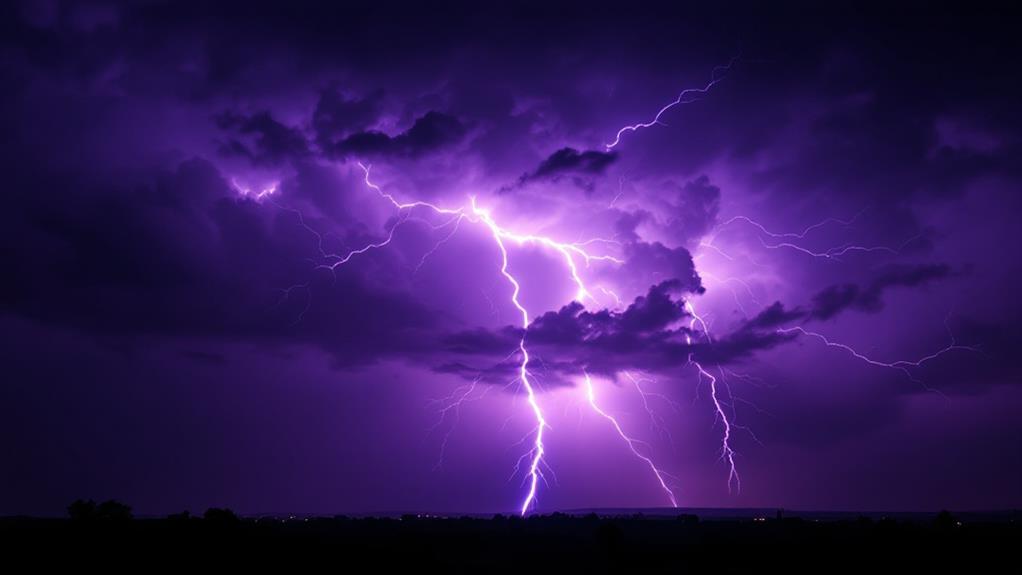
While blue lightning enthralls with its cool hues, purple lightning enchants with its regal appearance. You'll find that this stunning phenomenon occurs due to unique atmospheric conditions and can display variations in shade from lavender to deep violet.
Purple lightning is relatively rare and often appears during intense thunderstorms. It's created when there's a high concentration of water droplets and ice crystals in the atmosphere. These particles scatter the light from the lightning bolt, filtering out other colors and leaving behind the purple hue you see.
The exact shade of purple can vary depending on factors like humidity, temperature, and the presence of dust or pollutants in the air. Sometimes, you might observe a pinkish-purple lightning, which occurs when red and blue light combine in the atmosphere.
To witness purple lightning, your best bet is to look for it during powerful storms, especially those occurring at sunset or twilight. The low angle of the sun at these times can enhance the purple coloration, making for a truly spectacular sight that you won't soon forget.
Red Lightning
Red lightning crackles across the sky, mesmerizing observers with its fiery appearance. This rare phenomenon occurs when electrical discharges in the atmosphere interact with specific atmospheric conditions. You'll notice that red lightning can manifest in different hues, ranging from deep crimson to bright scarlet.
The rare occurrences of red lightning are often associated with high-altitude lightning events. These typically happen above thunderstorms, in the upper regions of the atmosphere. Scientists have identified two main types of red lightning: sprites and ELVES (Emission of Light and Very Low Frequency Perturbations due to Electromagnetic Pulse Sources).
Sprites are vertical columns of red light that extend upwards from the top of thunderclouds. They're incredibly fast, lasting only milliseconds. ELVES, on the other hand, appear as expanding rings of red light high above thunderstorms. Both phenomena are challenging to observe from the ground due to their brief duration and high altitude.
If you're lucky enough to witness red lightning, you're experiencing one of nature's most elusive and spectacular displays. Remember, these events are fleeting, so keep your eyes peeled and your camera ready to capture this extraordinary sight.
Orange Lightning
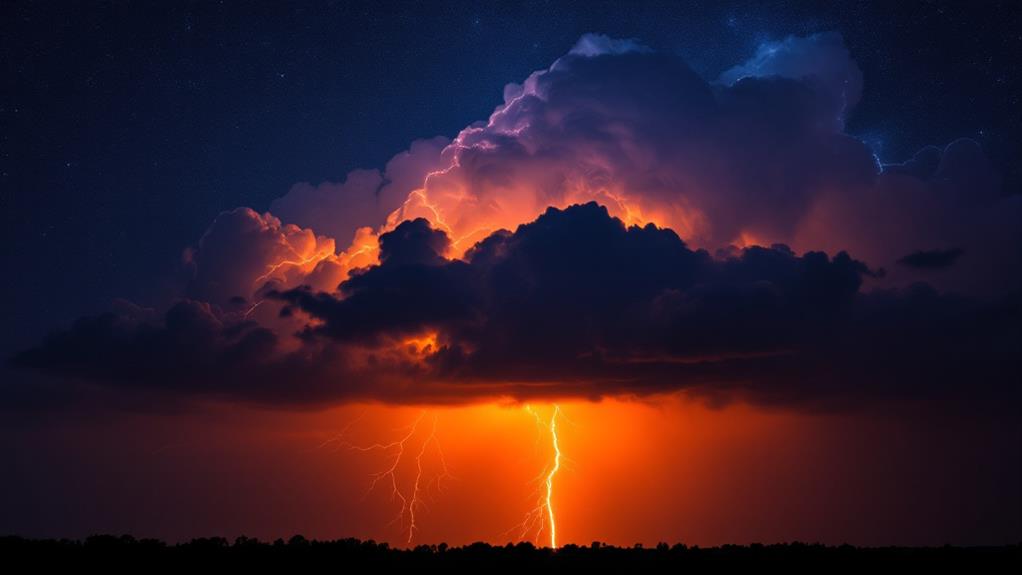
Orange lightning streaks across the sky, casting an eerie glow over the terrain. You'll witness this phenomenon during intense thunderstorms, particularly when there's a high concentration of dust or smoke in the atmosphere. The bright glow of orange lightning results from the electrical discharge interacting with these particles, creating a stunning visual display.
To fully appreciate orange lightning, consider these fascinating aspects:
- Rarity: Orange lightning is less common than white or blue lightning, making it a special sight.
- Atmospheric conditions: It often occurs during wildfires or dust storms, when particulates are abundant.
- Intensity: The orange hue can vary from pale peach to deep amber, depending on atmospheric composition.
- Photographic challenges: Capturing orange lightning requires specific camera settings and timing.
You'll find that orange lightning isn't just visually striking; it also provides cherished information about atmospheric conditions. Scientists study these colorful electrical discharges to better understand air quality, pollution levels, and weather patterns. Next time you spot orange lightning illuminating the sky, remember that you're witnessing a unique interplay between nature's raw power and the environment's composition.
Yellow Lightning
Yellow lightning lights up the sky with its radiant, golden hue, mesmerizing observers with its intense beauty. You'll notice its distinctive appearance as it streaks across the heavens, illuminating everything in its path with a bright yellow glow. This type of lightning occurs when the electrical discharge passes through air with a higher concentration of dust, smoke, or other particulates.
The bright yellow hue of this lightning is caused by the excitation of sodium atoms in the atmosphere. When the powerful electrical current interacts with these particles, it creates a dazzling display that's hard to miss. You might spot yellow lightning during dry, dusty conditions or in areas with polluted air.
While it's less common than white or blue lightning, yellow lightning can be just as awe-inspiring. Its golden color often appears more intense against a dark night sky, creating a striking contrast. Remember, though, that all lightning is dangerous, regardless of its color. Always seek shelter when you see any type of lightning, including the spellbinding yellow variety.
Green Lightning
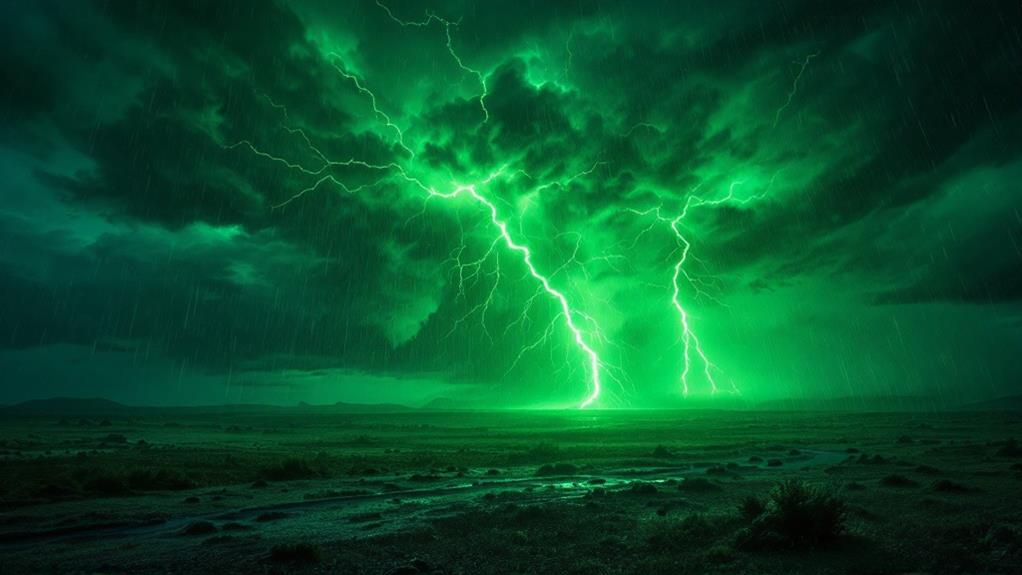
Witnessing green lightning is a rare and mesmerizing experience that'll leave you in awe. This unusual color combination in the sky occurs during specific atmospheric conditions, making it one of the rarest lightning occurrences you might ever encounter. Green lightning is typically associated with severe thunderstorms and can be seen more frequently in certain regions of the world.
To better understand green lightning, consider these key points:
- Cause: It's primarily caused by the interaction of lightning with high concentrations of water droplets and ice crystals in the atmosphere.
- Appearance: The green hue is often described as a brief flash or tint within a typical lightning bolt.
- Timing: It's most commonly observed during the initial stages of a thunderstorm.
- Location: Coastal areas and regions with high humidity are more likely to experience green lightning.
You'll find that green lightning is often accompanied by other rare lightning occurrences, such as ball lightning or sprites. While it's an enthralling phenomenon, it's crucial to remember that all lightning is dangerous, regardless of its color. Always prioritize safety when observing these stunning displays of nature's power.
Pink Lightning
While incredibly rare, pink lightning is a spectacular atmospheric phenomenon that can leave observers spellbound. You'll find that this unique color occurs under specific atmospheric conditions, typically during severe thunderstorms or volcanic eruptions. The pinkish hue results from a combination of factors, including the presence of dust particles, moisture, and the way light scatters through the atmosphere.
When you witness hazy pink lightning, you're seeing the effects of light refraction through layers of moisture and particulate matter in the air. This diffusion creates a soft, glowing appearance that's distinctly different from typical lightning strikes. Streaking pink lightning, on the other hand, appears as vivid bolts cutting through the sky, often accompanied by a reddish tinge.
You'll most likely encounter pink lightning in areas with high concentrations of dust or volcanic ash in the atmosphere. These particles scatter red light more efficiently, lending the lightning its characteristic pink color. While beautiful, pink lightning serves as a warning sign of potentially hazardous weather conditions, so it's essential to seek shelter if you observe this phenomenon.
Factors Affecting Lightning Color
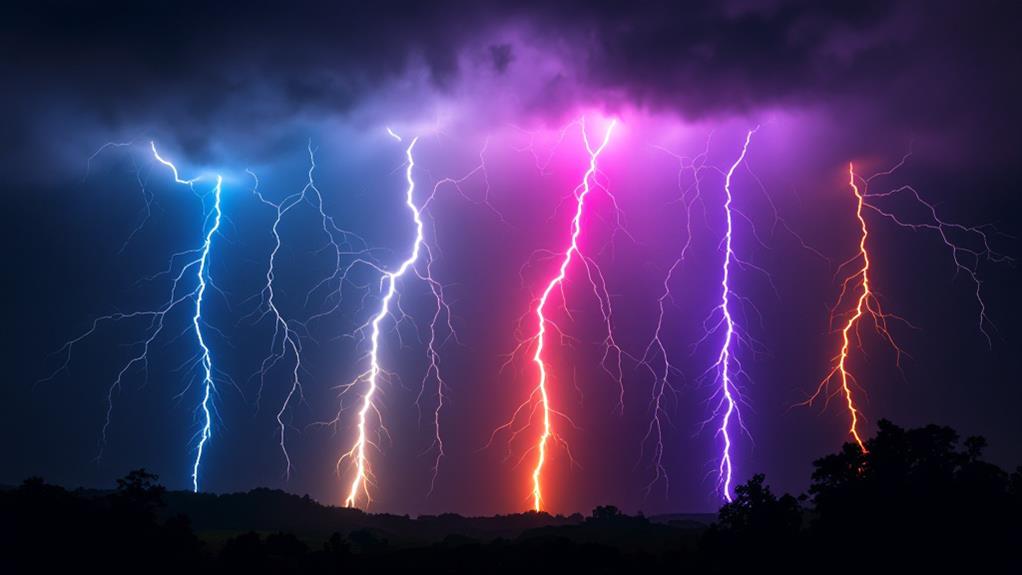
The color palette of lightning strikes is influenced by several key factors. When you're observing a thunderstorm, you'll notice that not all lightning bolts look the same. This variation in color is due to a combination of atmospheric conditions and electrical charge dispersion.
The farther away you are from the lightning, the more likely you'll see it as a white or blue color due to light scattering. Higher humidity can create a more diffused appearance, often resulting in a hazier, less vibrant color. Dust and pollutants in the air can alter the lightning's color by absorbing or reflecting certain wavelengths of light. The temperature of the lightning bolt itself plays an essential role, with hotter bolts appearing white or blue and cooler ones taking on a reddish hue. Atmospheric conditions also affect the electrical charge dispersion, which can influence the intensity and color of the lightning you see.
Frequently Asked Questions
Can Lightning Strike the Same Place Twice?
Yes, lightning can strike the same place twice, and it often does. You might be surprised to learn that certain locations are more prone to repeat strikes due to their height, composition, or surrounding environment. Lightning strikes patterns show that tall structures and raised areas are particularly susceptible. The likelihood of repeat strikes increases in these locations, which is why lightning rods are vital for protecting buildings. Don't assume you're safe just because an area has been struck before—nature doesn't follow those rules.
How Hot Is a Lightning Bolt?
You'd be shocked to know just how hot a lightning bolt can get. Lightning's intense temperature reaches a staggering 50,000 degrees Fahrenheit, about five times hotter than the sun's surface! This extreme heat results from lightning's high resistance as it travels through the air. When you see a strike, you're witnessing an incredibly powerful burst of energy that can instantly vaporize water and turn sand into glass. It's nature's own spectacular light show with scorching consequences.
What Is the Average Duration of a Lightning Flash?
You might be surprised to learn that the average lightning flash duration is incredibly brief. Typically, a lightning bolt lasts for just 30 to 50 microseconds. That's less than a blink of an eye! However, you'll find that there's a relationship between lightning intensity and flash duration. More intense lightning strikes tend to have longer durations. You may occasionally witness a flash that seems to linger, but that's usually multiple strikes occurring in rapid succession.
Is It Possible to Predict Where Lightning Will Strike?
While you can't pinpoint exactly where lightning will strike, you can predict potential strike areas. By identifying lightning precursors, such as increasing electrical fields and cloud formations, you'll gain meaningful findings. Analyzing weather patterns, including atmospheric conditions and storm cell movements, helps you anticipate high-risk zones. Advanced technologies like lightning detection systems and Doppler radar also aid in forecasting. Remember, these methods improve your chances of predicting lightning-prone areas, but they're not 100% accurate.
How Far Can Lightning Travel Horizontally Before Striking the Ground?
You might be surprised by how far lightning can travel horizontally. Horizontal lightning travel distance can reach up to 10 miles from its origin point. This means the horizontal lightning strike radius can extend considerably beyond where you see the storm. Don't assume you're safe just because the storm seems distant. Lightning can strike even when skies above you appear clear. Always seek shelter when you hear thunder, as it indicates lightning's potential to reach your location.

